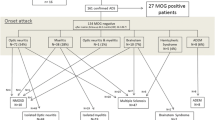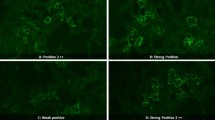Abstract
Introduction
Antibodies to myelin oligodendrocyte glycoprotein (MOG) have been demonstrated in patients with optic neuritis (ON), encephalitis and myelitis.
Objective
To describe the clinical and paraclinical features in patients with MOG-associated demyelination, focusing on unusual cases, brain biopsy and concomitant autoimmunity.
Methods
A single centre retrospective observational case series, analysing demographic, clinical, laboratory, histopathology and radiological data from MOG- positive patients.
Results
We identified 20 adults. The male/female ratio was 1.5. Mean age at onset was 31.6 years and mean disease duration was 7.5 years. The most frequent presentation was myelitis (45%), followed by ON (30%). One case had simultaneous myelitis and ON. Two patients had a cortical syndrome, 1 patient had an encephalopathic presentation and 1 cryptogenic focal epilepsy. Anti-neutrophil cytoplasmic antibodies (ANCA) were found in 3 cases, while 1 patient had an antibody to glutamic acid decarboxylase (GAD). Brain biopsy was performed in 2 patients. Relapsing course was identified in 60% of patients. We also discuss 3 cases with atypical features, brain histopathology and concomitant autoimmunity.
Conclusion
MOG- associated demyelination represents a new disease entity. Unusual cases are reported, expanding the disease spectrum. Elucidating this further should be the focus of prospective studies.





Similar content being viewed by others
References
Wynford-Thomas R, Jacob A, Tomassini V (2019) Neurological update: MOG antibody disease. J Neurol 266:1280–1286
Reindl M, Jarius S, Rostasy K et al (2017) Myelin oligodendrocyte glycoprotein antibodies: how clinically useful are they? Curr Opin Neurol 30:295–301
Oliveira LM, Apostolos-Pereira SL, Pitombeira MS et al (2018) Persistent MOG-IgG positivity is a predictor of recurrence in MOG-IgG-associated optic neuritis, encephalitis and myelitis. Mult Scler. https://doi.org/10.1177/1352458518811597
Jurynczyk M, Jacob A, Fujihara K et al (2018) Myelin oligodendrocyte glycoprotein (MOG) antibody-associated disease: practical considerations. Pract Neurol 19(3):187–195
Jarius S, Paul F, Aktas O et al (2018) MOG encephalomyelitis: international recommendations on diagnosis and antibody testing. J Neuroinflammation 15:134
Waters P, Woodhall M, O’Connor KC et al (2015) MOG cell-based assay detects non-MS patient with inflammatory neurologic disease. Neurol Neuroimmunol Neuroinflamm 2:e89
Waters P, Komorowski L, Woodhall M et al (2019) A multicentre comparison of MOG-IgG cell-based assays. Neurology 92:e1250–e1255
Wingerchuck DM, Banwell B, Bennett JL et al (2015) International consensus diagnostic criteria for neuromyelitis optica spectrum disorders. Neurology 85:177–189
Jurynczyk M, Messina S, Woodhall MR et al (2017) Clinical presentation and prognosis in MOG-antibody disease: a UK study. Brain 140:3128–3138
Cobo-Calvo A, Ruiz A, Maillart E et al (2018) Clinical spectrum and prognostic value of CNS MOG autoimmunity in adults: the MOGADOR study. Neurology 90:e1858–e1869
Ogawa R, Nakashima I, Takahashi T et al (2017) MOG-antibody-positive, benign, unilateral, cerebral cortical encephalitis with epilepsy. Neurol Neuroimmunol Neuroinflamm 4:e322
Hamid SHM, Whittam D, Saviour M et al (2018) Seizures and encephalitis in myelin oligodendrocyte glycoprotein IgG disease vs aquaporin 4 IgG disease. JAMA Neurol 75:65–71
Jarius S, Ruprecht K, Kleiter I et al (2016) MOG-IgG in NMO and related disorders: a multicentre study of 50 patients. Part 2: epidemiology, clinical presentation, radiological and laboratory features, treatment responses, and long-term outcome. J Neuroinflammation 13:280
Salma S, Khan M, Levy M et al (2019) Radiological characteristics of myelin oligodendrocyte glycoprotein antibody disease. Mult Scler Relat Disord 29:15–22
Wang L, ZhangBao J, Zhou L et al (2019) Encephalitis is an important clinical component of myelin oligodendrocyte glycoprotein antibody associated demyelination: a single-center cohort study in Shanghai, China. Eur J Neurol 26:168–174
Zhong X, Zhou Y, Chang Y et al (2019) Seizure and myelin oligodendrocyte glycoprotein antibody-associated encephalomyelitis in a retrospective cohort of chinese patients. Front Neurol 10:415
Dos Passos GR, Oliveira LM, da Costa BK et al (2018) MOG-IgG-associated optic neuritis, encephalitis, and myelitis: lessons learned from neuromyelitis optica spectrum disorder. Front Neurol 9:217
Komatsu T, Matsushima S, Kaneko K et al (2019) Perivascular enhancement in anti-MOG antibody demyelinating disease of the CNS. J Neurol Neurosurg Psychiatry 90:111–112
Weber MS, Derfuss T, Metz I et al (2018) Defining distinct features of anti-MOG antibody associated central nervous system demyelination. Ther Adv Neurol Disord 11:1–15
Spadaro M, Gerdes LA, Mayer MC et al (2015) Histopathology and clinical course of MOG-antibody-associated encephalomyelitis. Ann Clin Transl Neurol 2:295–301
Subesinghe S, van Leuven S, Yalakki L et al (2018) Cocaine and ANCA associated vasculitis-like syndromes—a case series. Autoimmun Rev 17:73–77
Marquez J, Aguirre L, Munoz C et al (2017) Cocaine-levamisole-induced vasculitis/vasculopathy syndrome. Curr Rheumatol Rep 19:36
Zheng Y, Zhang Y, Cai M et al (2019) Central Nervous System Involvement in ANCA-Associated Vasculitis: What Neurologists Need to Know. Front Neurol 9:1166
Salama S, Khan M, Pardo S et al (2019) MOG antibody-associated encephalomyelitis/encephalitis. Mult Scler. https://doi.org/10.1177/1352458519837705
Budhram A, Mirian A, Le C et al (2019) Unilateral cortical FLAIR-hyperintense Lesions in Anti-MOG-associated Encephalitis with Seizures (FLAMES): characterization of a distinct clinic-radiographic syndrome. J Neurol. https://doi.org/10.1007/s00415-019-09440-8
Lopez-Chiriboga AS, Majed M, Fryer J et al (2018) Association of MOG-IgG serostatus with relapse after acute disseminated encephalomyelitis and proposed diagnostic criteria for MOG-IgG-associated disorders. JAMA Neurol 75:1355–1363
Spadaro M, Gerdes LA, Krumbholz M et al (2016) Autoantibodies to MOG in a distinct subgroup of adult multiple sclerosis. Neurol Neuroimmunol Neuroinflamm 3:e257
Cobo-Calvo A, Sepulveda M, Bernard-Valnet R et al (2016) Antibodies to myelin oligodendrocyte glycoprotein in aquaporin 4 antibody seronegative longitudinally extensive transverse myelitis: Clinical and prognostic implications. Mult Scler 22:312–319
Baba T, Shinoda K, Watanabe M et al (2019) MOG antibody disease manifesting as progressive cognitive deterioration and behavioural changes with primary central nervous system vasculitis. Mult Scler Relat Disord 30:48–50
Patterson K, Iglesias E, Nasrallah M et al (2019) Anti-MOG encephalitis mimicking small vessel CNS vasculitis. Neurol Neuroimmunol Neuroinflamm 6:e538
Titulaer MJ, Hoftberger R, Iizuka T et al (2014) Overlapping demyelinating syndromes and anti-N-methyl-d-aspartate receptor encephalitis. Ann Neurol 75:411–428
Fan S, Xu Y, Ren H et al (2018) Comparison of myelin oligodendrocyte glycoprotein (MOG)-antibody disease and AQP4-IgG-positive neuromyelitis optica spectrum disorder (NMOSD) when they co-exist with anti-NMDA (N-methyl-d-aspartate) receptor encephalitis. Mult Scler Relat Dosord 20:144–152
Baizabal-Carvallo JF (2019) The neurological syndromes associated with glutamic acid decarboxylase antibodies. J Autoimmun 101:35–47
Macaron G, Ontaneda D (2019) MOG-related disorders: a new cause of imaging-negative myelitis? Mult Scler. https://doi.org/10.1177/1352458519840746
Sundaram S, Nair SS, Jaganmohan D et al (2019) Relapsing lumbosacral myeloradiculitis: an unusual presentation of MOG antibody disease. Mult Scler. https://doi.org/10.1177/1352458519840747
Reindl M, Waters P (2019) Myelin oligodendrocyte glycoprotein antibodies in neurological disease. Nat Rev Neurol 15:89–102
Acknowledgements
We thank the patients who gave consent for us to report their individual cases. We thank Dr N. Evangelou, Dr C. Gilmore and Dr B. Gran, who provided patients for this study. We thank Dr G. Sare for critically reading the manuscript and useful comments.
Funding
This research received no specific grant from any funding agency in the public, commercial, or not-for-profit sectors.
Author information
Authors and Affiliations
Corresponding author
Ethics declarations
Conflicts of interest
The authors declare that there is no conflict of interest.
Ethical standards
The study was approved by the Quality and Safety Committee of Nottingham University Hospitals NHS Trust.
Rights and permissions
About this article
Cite this article
Papathanasiou, A., Tanasescu, R., Davis, J. et al. MOG-IgG-associated demyelination: focus on atypical features, brain histopathology and concomitant autoimmunity. J Neurol 267, 359–368 (2020). https://doi.org/10.1007/s00415-019-09586-5
Received:
Revised:
Accepted:
Published:
Issue Date:
DOI: https://doi.org/10.1007/s00415-019-09586-5




